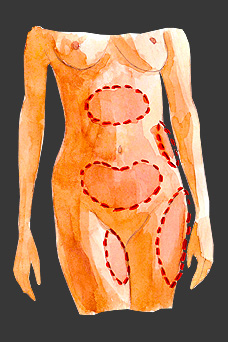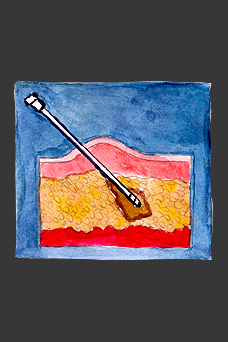Fat-derived stem cell transplantation is an anti-aging procedure designed to rejuvenate your face, to heal chronic wounds, or to enhance parts of the body. This procedure uses stem cells together with fat transfer. Stem cells are extracted from patient's own fat, so the liposuction and stem cells transplantation are performed together.
Procedure
First of all, fat harvesting is carried out using a special cannula. Several hundred cubic centimetres of adipose tissue have to be vacuumed in order to get several cubic centimetres of stem cells. Usually, fat is harvested from the abdomen, hips or waist. Subsequently the fat is processed in a special device. It is exposed to enzymes, filtered and centrifuged, and finally the stem cells are separated from the adipose tissue. The prepared concentrate of stem cells can be injected into those parts of your body that you want to look younger, such as around the eyes or lips, or any other facial area. It has been proven that stem cells extracted from a patient’s own adipose tissue can accelerate healing of chronic, complicated wounds. Stem cells can also be mixed with fat prepared for fat grafting. In this case, stem cell-enriched fat is used for breast or buttock augmentation, face rejuvenation, wrinkle treatment, breast reconstruction, and correction of other defects. Using stem cell-enriched fat enables us to achieve better results.
| Fat harvesting | ||||
 |
 |
|||
| Typical zones for fat harvesting | Fat harvesting cannula in subcutaneous tissue | |||
Operation risks
As stem cell transplantation is basically liposuction and fat transfer at the same time, the procedure carries with it the same adverse reactions as associated with those procedures. Some patients may experience a reaction to the anaesthesia, pain, burning sensations, bruising, secretions at the sites of skin incisions, occurrence of skin excess, or infection. Other possible complications or adverse reactions should be discussed with the plastic surgeon during the consultation.
Postoperative period
The patient can usually return to work in 1-2 weeks. Patients are advised to avoid active physical exercise for an additional 2-4 weeks.
The rejuvenation and regeneration processes are initiated at the time of the transplant, so the final results will only be visible a year or more after the procedure. Stem cell transplantation shows lasting results, but these also depend to a large extent on the patient's lifestyle, diet, and physical activity.
| Tautrimas Aštrauskas - Certified Plastic & Reconstructive Surgeon www.blossomandjasmine.com |
 |
 |
 |
solution: inverse.lt |
